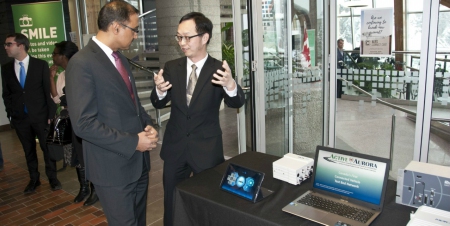
Transportation engineering researcher Tony Qiu describes his ACTIVE-AURORA connected vehicle technology to Minister Amarjeet Sohi at a funding announcement Jan. 26.
(Edmonton) New technology that allows cars to "talk" with each other is one of three University of Alberta projects that will share in almost $3.3 million in federal funding earmarked to support the development and commercialization of clean technologies and products.
The projects to be funded by Western Economic Diversification Canada include $843,400 for research into and production of low-cost and high-capacity battery materials for microgrid-scale energy storage, $1.5 million to expand the university's fermentation scale-up and downstream processing capabilities, and a $934,000 investment in ACTIVE-AURORA, Canada's first network of test beds for connected vehicles (CV).
CV technology enables vehicles to wirelessly talk to other vehicles and roadside infrastructure in real time, communicating information such as location, speed, following distance, inclement weather, adverse road conditions and more. ACTIVE-AURORA is testing its technology in Edmonton along the northwest corner of Anthony Henday Drive, the eastern portion of Whitemud Drive and on 23rd Avenue.
Project lead Tony Qiu, a transportation engineering researcher, said this federal contribution will help address the problem of traffic congestion, improve road safety and, ultimately, reduce greenhouse gas emissions.
"Our objective is to identify CV applications relevant to Western Canada that could have a positive effect on the environment by reducing fuel consumption, improving the efficiency of vehicles and reducing emissions," said Qiu.
An example of an environmental CV application, according to Qiu, is an energy-efficient intersection that optimizes how vehicles move through it. He said avoiding unnecessary vehicle acceleration or braking reduces the energy used and the emissions generated.
Qiu said this technology is part of "a transportation revolution underway that will be as disruptive as the invention of the first automobile.
"New technology allows us to travel in greater safety, deliver goods and people on time and even reduce greenhouse gas emissions," said Qiu. "As roads, cars and people become connected and share information, our daily lives will improve."
ACTIVE-AURORA launched in 2014 as a collaborative effort by the Government of Canada, the Government of Alberta, the City of Edmonton, the U of A's Centre for Smart Transportation and the University of British Columbia. From industry, Stantec is providing project management, design and construction administration services, and EPCOR and Can-Traffic are installing the roadside infrastructure.
The aim of microgrids is to provide energy to remote communities without being connected to a main electrical grid. The federal government's investment will support the development and commercialization of microgrids to improve energy storage for renewables including solar and wind.
"The world is in the early stages of a global transition to a low-carbon economy," said project lead Jillian Buriak, whose research focuses on developing nanomaterials for energy. "Energy storage is a critical component for enabling integration of Canada's vast but intermittent renewable solar and wind energy resources. A made-in-Canada solution to integrating new batteries and microgrids will help both large and small communities take advantage of low-carbon energy sources available to them."
The investment for the fermentation scale-up and downstream processing capabilities at the U of A's South Campus comes as industry looks for products that require less energy during production and generate fewer greenhouse gases, such as biodegradable plastic, probiotics and fertilizer.
"This contributions from Western Economic Diversification Canada will assist the nascent natural health products industry of Alberta and take development of new natural health products in Alberta to the next level," said Heather Bruce, project lead and agrifood researcher.